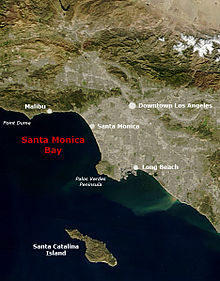
Santa Monica is a city in Los Angeles County, situated along Santa Monica Bay on California's South Coast. Santa Monica's 2020 U.S. Census population was 93,076. Santa Monica is a popular resort town, owing to its climate, beaches, and hospitality industry. It has a diverse economy, hosting headquarters of companies such as Hulu, Activision Blizzard, Universal Music Group, Lionsgate, Illumination and The Recording Academy.
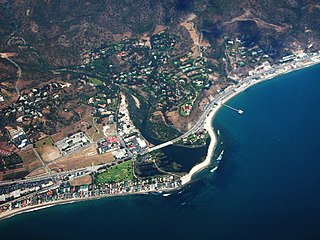
Malibu is a beach city in the Santa Monica Mountains region of Los Angeles County, California, about 30 miles (48 km) west of Downtown Los Angeles. It is known for its Mediterranean climate, its strip of beaches stretching 21 miles along the Pacific Ocean coast, and for its longtime status as the home of numerous affluent Hollywood celebrities and executives. Although a high proportion of its residents are entertainment industry figures with million-dollar mansions, Malibu also features several middle- and upper-middle-class neighborhoods. The Pacific Coast Highway traverses the city and has led most residents to settle anywhere from half a mile to within a few hundred yards of it, with some residents living up to one mile away from the beach in areas featuring narrow canyons. As of the 2020 census, the city's population was 10,654.

Santa Monica Bay is a bight of the Pacific Ocean in Southern California, United States. Its boundaries are slightly ambiguous, but it is generally considered to be the part of the Pacific within an imaginary line drawn between Point Dume, in Malibu, and the Palos Verdes Peninsula. Its eastern shore forms the western boundary of the Los Angeles Westside and South Bay regions. Although it was fed by the Los Angeles River until the river's catastrophic change of course in 1825, the only stream of any size now flowing into it is Ballona Creek. Smaller waterways draining into the bay include Malibu Creek, Topanga Creek, and Santa Monica Creek.

The Santa Monica Pier is a large pier at the foot of Colorado Avenue in Santa Monica, California, United States. It contains a small amusement park, concession stands, and areas for views and fishing. The pier is part of the greater Santa Monica Mountains National Recreation Area.
The history of Santa Monica, California, covers the significant events and movements in Santa Monica's past.

Marine debris, also known as marine litter, is human-created waste that has deliberately or accidentally been released in a sea or ocean. Floating oceanic debris tends to accumulate at the center of gyres and on coastlines, frequently washing aground, when it is known as beach litter or tidewrack. Deliberate disposal of wastes at sea is called ocean dumping. Naturally occurring debris, such as driftwood and drift seeds, are also present. With the increasing use of plastic, human influence has become an issue as many types of (petrochemical) plastics do not biodegrade quickly, as would natural or organic materials. The largest single type of plastic pollution (~10%) and majority of large plastic in the oceans is discarded and lost nets from the fishing industry. Waterborne plastic poses a serious threat to fish, seabirds, marine reptiles, and marine mammals, as well as to boats and coasts.
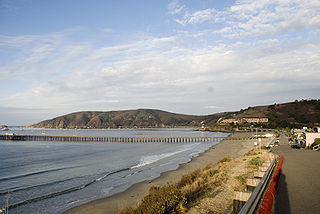
Avila Beach is an unincorporated community in San Luis Obispo County, California, United States, located on San Luis Obispo Bay about 160 miles (257 km) northwest of Los Angeles, and about 200 miles (320 km) south of San Francisco. The population was 1,576 at the 2010 census. For statistical purposes, the United States Census Bureau has defined Avila Beach as a census-designated place (CDP).

The Hyperion Water Reclamation Plant is a sewage treatment plant in southwest Los Angeles, California, next to Dockweiler State Beach on Santa Monica Bay. The plant is the largest sewage treatment facility in the Los Angeles Metropolitan Area and one of the largest plants in the world. Hyperion is operated by the City of Los Angeles, Department of Public Works, and the Bureau of Sanitation. Hyperion is the largest sewage plant by volume west of the Mississippi River.

The Marvin Braude Bike Trail is a 22-mile (35 km) paved bicycle path that runs mostly along the shoreline of Santa Monica Bay in Los Angeles County, California. The coastal bike trail is widely acknowledged as Los Angeles’ “most popular bike path.”
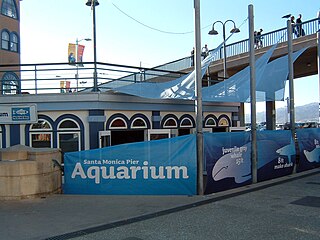
Heal the Bay Aquarium, previously named the Santa Monica Pier Aquarium, is a private-public aquarium at a California State Beach Park managed by Los Angeles County Department of Beaches and Harbors, located beneath the Santa Monica Pier, adjacent to the Pacific Ocean. Since 2003, it is operated by Heal the Bay, a nonprofit organization. It was formerly known as the Ocean Discovery Center and was operated by UCLA until 2003.
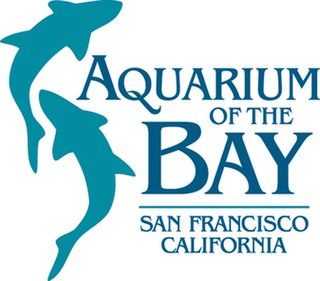
Aquarium of the Bay is a public aquarium located at The Embarcadero and Beach Street, at the edge of Pier 39 in San Francisco, California. The aquarium is focused on local aquatic animals from the San Francisco Bay and neighboring rivers and watersheds as far as the Sierra Mountains. Since 2005 the Aquarium has focused its mission on enabling ocean conservation and climate action both locally and globally. It is one of seven institutions under parent company Bay Ecotarium, the largest watershed conservation organization in the Bay Area

Santa Monica State Beach is a California State Park operated by the city of Santa Monica.

Moonlight State Beach is a state beach in Encinitas, California. It is located one fifth of one mile beyond the point where Encinitas Boulevard turns into B Street after it crosses Highway 101.

Alamitos Bay is an inlet on the Pacific Ocean coast of southern California, United States, between the cities of Long Beach and Seal Beach, at the outlet of the San Gabriel River. It is near Los Angeles.
Save Our Shores (SOS) is a marine conservation nonprofit dedicated to "foster thriving and sustainable ecosystems in the Monterey Bay and surrounding habitats through equitable environmental action.”

Marina DeBris is the name used by an Australian-based artist whose work focuses on reusing trash to raise awareness of ocean and beach pollution. DeBris uses trash washed up from the beach to create trashion, 'fish tanks', decorative art and other works of art. She has also used beach trash to provide one perspective on what the earth might look like from space. As well as creating art from debris, DeBris also is a fund raiser for environmental organizations, and collaborates with non-profit organizations and schools to educate children about ocean pollution. In 2021, DeBris found almost 300 face masks on beaches, and used them in her trashion and other displays.
Save the Plastic Bag Coalition v. City of Manhattan Beach is a California Supreme Court case, decided by a full majority on July 14, 2011, in which the plaintiffs challenged the City of Manhattan Beach's ordinance banning single-use plastic bags.
County Line Beach is beach park located in Solromar, an unincorporated community of Ventura County. This stretch of sandy beach is easily accessible from the adjacent Pacific Coast Highway. This popular surf spot is administered as part of Leo Carrillo State Park. The beach lies within the south coast portion of the Ventura County amidst a mostly rugged coastline that is some of the most striking and diverse coastal terrain in the County. The beach lies at the mouth of a canyon in the Santa Monica Mountains that hug the shore along the Ventura County's south coast.
Hillary Rika Hauser is an American photojournalist and environmental activist with a focus on the oceans — underwater diving adventure, politics, and conservation. In 2009, in recognition of her ocean environmental work as it relates to underwater diving, Hauser received the NOGI Award for Distinguished Service from the Academy of Underwater Arts and Sciences. In 2013 the Academy elected Hauser as president of its board of directors.

The Long Wharf in Santa Monica, also known as Port Los Angeles or the Mile Long Pier, was an extensive pier wharf constructed by the Southern Pacific Railroad Company in Santa Monica Bay from 1892 to 1894. When it opened in 1894, it was the longest wharf in the world, measuring approximately 4,700 feet (1,400 m). It served as a cargo and passenger port until 1913, and in 1919 removal of the wharf started. The wharf, the 1,000 foot (300 m) tip of the pier, was removed by 1920. The remaining 3,600 feet (1,100 m) of pier was used as a run down fishing pier until 1933, when the remainder of the pier was removed. One of the major imports to the wharf was lumber from Northern ports, to help in the construction boom in Southern California. Southern Pacific Railroad and the street cars of the Los Angeles Pacific Railroad served the wharf. Los Angeles Pacific Railroad ran passenger trams to the wharf and from midnight to sunrise ran cargo cars.

